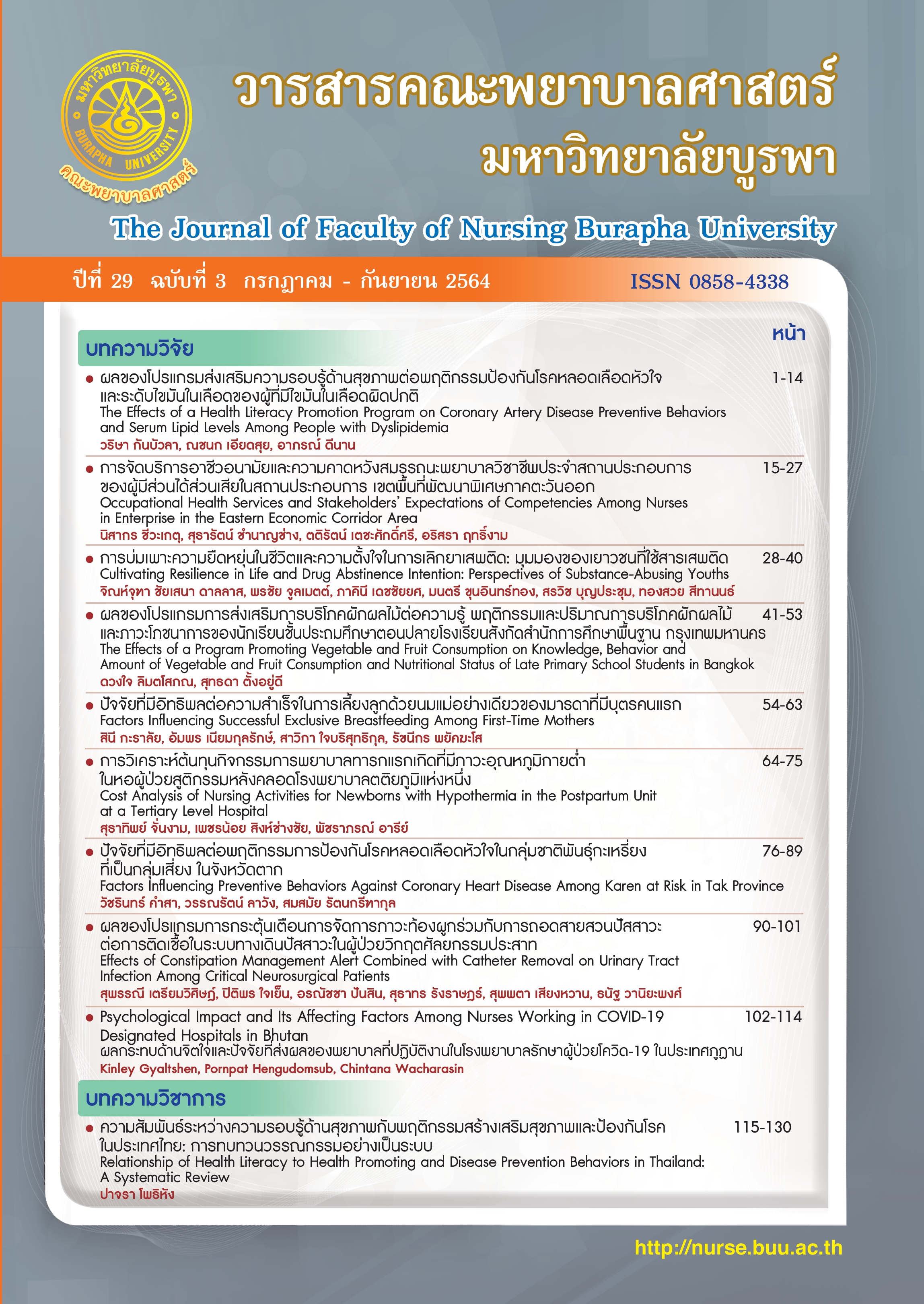การจัดบริการอาชีวอนามัยและความคาดหวังสมรรถนะพยาบาลวิชาชีพ ประจำสถานประกอบการของผู้มีส่วนได้ส่วนเสียในสถานประกอบการ เขตพื้นที่พัฒนาพิเศษภาคตะวันออก
คำสำคัญ:
พยาบาลอาชีวอนามัย, สมรรถนะ, สถานประกอบการ, เขตพัฒนาพื้นที่พิเศษภาคตะวันออกบทคัดย่อ
การศึกษาแบบบรรยายนี้ มีวัตถุประสงค์เพื่อศึกษาการจัดบริการอาชีวอนามัย ความคาดหวังสมรรถนะพยาบาลวิชาชีพ และเปรียบเทียบความคาดหวังสมรรถนะพยาบาลวิชาชีพของผู้มีส่วนได้ส่วนเสียในสถานประกอบการ จำแนกตามประเภทอุตสาหกรรม สัญชาติของเจ้าของสถานประกอบการ การจัดเวลาปฏิบัติงาน การฝึกอบรมด้านอาชีวอนามัยและความปลอดภัย กลุ่มตัวอย่าง คือ ผู้บริหาร ผู้จัดการฝ่ายบริหารบุคคล และเจ้าหน้าที่ความปลอดภัยระดับวิชาชีพของสถานประกอบการเขตพื้นที่พัฒนาพิเศษภาคตะวันออก จำนวน 405 คน เก็บรวบรวมข้อมูลโดยใช้แบบสอบถามการจัดบริการอาชีวอนามัยของสถานประกอบการ และความคาดหวังสมรรถนะพยาบาลวิชาชีพประจำสถานประกอบการ ของผู้มีส่วนได้ส่วนเสีย วิเคราะห์ข้อมูลโดยสถิติเชิงพรรณนาและค่าทีชนิดเป็นอิสระต่อกัน
ผลการวิจัยพบว่า สถานประกอบการจำนวนมากกว่าร้อยละ 90 มีการจัดบริการอาชีวอนามัยด้านความปลอดภัยในการทำงาน ด้านสุขภาพและด้านสิ่งแวดล้อมในการทำงานตามที่กฎหมายกำหนด ผู้มีส่วนได้ส่วนเสียคาดหวังสมรรถนะพยาบาลวิชาชีพด้านการรักษาพยาบาลในระดับมากที่สุด (M = 3.6, SD = 0.6) และมีความคาดหวังด้านการป้องกันโรค/อุบัติเหตุจากการทำงาน การสร้างเสริมสุขภาพ การฟื้นฟูสภาพ และการบริหารงานอาชีวอนามัยในระดับมาก คะแนนเฉลี่ยความคาดหวังสมรรถนะพยาบาลวิชาชีพของผู้มีส่วนได้ส่วนเสียในสถานประกอบการแตกต่างกันตามสัญชาติของเจ้าของสถานประกอบการและการฝึกอบรมด้านอาชีวอนามัยและความปลอดภัยอย่างมีนัยสำคัญทางสถิติ (p < .05) โดยสถานประกอบการที่มีเจ้าของเป็นคนต่างชาติมีคะแนนเฉลี่ยความคาดหวังสมรรถนะมากกว่าเจ้าของที่เป็นคนไทย และผู้ที่เคยผ่านการอบรมมีคะแนนเฉลี่ยความคาดหวังสมรรถนะมากกว่าผู้ที่ไม่เคยฝึกอบรมอย่างมีนัยสำคัญทางสถิติ (p < .05) ดังนั้นพยาบาลวิชาชีพควรพัฒนาสมรรถนะของพยาบาลวิชาชีพทุกด้าน โดยเฉพาะด้านการรักษาพยาบาล เพื่อเพิ่มคุณภาพการจัดบริการอาชีวอนามัยในสถานประกอบการ
เอกสารอ้างอิง
Nurses. (2015). AAOHN competencies.
Workplace Health & Safety, 63(11), 484-492.
Chantian, P., Tantawutho, V., Jewchareonsakul, S.,
& Khemtong, P. (2012). Development of
professional competency standards of
occupational health nurses in industrial
enterprises. Journal of Nursing and
Education, 5(3), 102-119. [In Thai]
Department of Industrial Works. (2018). Machinery
registration procedures. Retrieved
December 2, 2017 from https://www.diw.
go.th/hawk/content.php?mode=data
service&tabid=1 [In Thai]
Harber, P., Alongi, G., & Su, J. (2014). Professional
activities of experienced occupational
health nurses. Workplace Health & Safety,
62(6), 233-242.
Kaewchantra, W., Chawapornpan, C., &
Kaewthummanukul, T. (2018). Nurses’ roles
in implementing occupational and
environmental health in workplaces.
Nursing Journal, 45(4), 84-96. [In Thai]
Kalampakorn, S. (2003). Occupational health
nursing in Thailand: Insight into international
occupational health. American Association
of Occupational Health Nurses, 51(2), 79-83.
[In Thai]
Lalloo, D., Demou, E., Kiran, S., Gaffney, M.,
Stevenson, M., & Macdonald, E. B. (2016).
Core competencies for UK occupational
health nurses: A delphi study. Occupational
Medicine, 66(8), 649-655.
La Torre, G., D’Andreano, F., Lecce, G., Di Muzio,
M., Chiarini, M., & Pulimeno, A. M. L. (2020).
The occupational health nurse and his/here
role in the prevention of work-related
diseases: Results of an observational study.
Annals of Hygiene: Ann Ig, 32(1), 3-15.
Marziale, M. H., Hong, O. S., Morris, J. A., Rocha,
F. L. (2010). The roles and functions of
occupational health nurses in Brazil and in
the United States. Revista Latino Americana
de Enfermagem, 18(2),182-188.
Nursing Division, Ministry of Public Health. (2014).
Standard of occupational health nursing.
Nonthaburi: Thep Phen Wanit. [In Thai]
The labour Protection Act (1998, February 12).
(1998). The Royal Thai Government
Gazette. pp. 34-36. [In Thai]
Rogers, B., Kono, K., Marziale, M. H., Peurala, M.,
Radford, J., & Staun, J. (2014). International
survey of occupational health nurses’
roles in multidisciplinary teamwork in
occupational health services. Workplace
Health & Safety, 62(7), 274-281.
Tiwari, R., Sharma, A., Zodpey, S., & Patel, S. (2015).
Occupational health nursing course in
India: Stakeholder’s perspective. J Environ
Occup Sci, 4(2), 111-113.
Wonglakon, S. (2010). Comparison of nursing
performance based on occupational
nursing standard in medium and large
factories at Amatanahorn industrial estate,
Chon Buri province. Journal of Nursing and
Education, 3(3), 12-26. [In Thai]
Vanichayobol, Y., Kalampakorn, S., & Suwanampai.,
P. (2016). Factors related to the
performance of occupational health
nurses in regional and general hospital
Sunder the office of the permanent
secretary for public health. Journal of
Nursing Division, 43(2), 83-100. [In Thai]
Yamane, T. (1973). Statistics: An introductory
analysis (3rd ed.). New York: Harper and Row
Publications.





